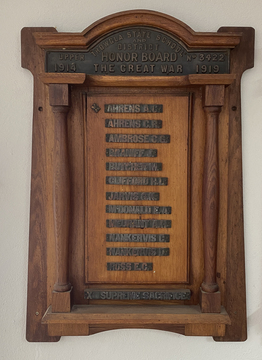BRANIFF, John
| Service Number: | 3349 |
|---|---|
| Enlisted: | 4 April 1917, Tamworth, NSW |
| Last Rank: | Trooper |
| Last Unit: | 1st Light Horse Regiment |
| Born: | Tumbarumba, New South Wales, Australia, 6 September 1895 |
| Home Town: | Not yet discovered |
| Schooling: | Not yet discovered |
| Occupation: | Teacher |
| Died: | Walcha, New South Wales, Australia, 3 August 1977, aged 81 years, cause of death not yet discovered |
| Cemetery: |
Walcha General Cemetery, N.S.W. |
| Memorials: | Corryong State School No 1309 Honor Roll, Corryong Upper Thowgla State School No 3422 & District Honor Board WW1, Hereford House Reunion Club Roll of Honour, Parramatta NSW Public School Teachers Who Served Abroard Honour Roll |
World War 1 Service
| 4 Apr 1917: | Enlisted AIF WW1, Trooper, 3349, 1st Light Horse Regiment, Tamworth, NSW | |
|---|---|---|
| 11 Jun 1917: | Involvement Private, 3349, 1st Light Horse Regiment, --- :embarkation_roll: roll_number: '1' embarkation_place: Sydney embarkation_ship: HMAT Port Lincoln embarkation_ship_number: A17 public_note: '' | |
| 11 Jun 1917: | Embarked Private, 3349, 1st Light Horse Regiment, HMAT Port Lincoln, Sydney | |
| 19 Jun 1919: | Discharged AIF WW1, Trooper, 3349, 1st Light Horse Regiment, Returned on HMNZT Ulimaroa |
John Braniff
When John Braniff was born in 1895 at Tumbarumba, New South Wales, his father, William John Braniff (1860 - 1928), was 35 and his mother, Elizabeth, nee Griffiths (1865 - 1934), was 30. John would have one brother and two sisters. Their names were Catherine (1894 to 1899), David (1897 to 1958) and Eileen Mary (1901 to ?).
On the 4 April, 1917, John enlisted in the AIF (Australian Imperial Forces) at Tamworth, New South Wales. He was given the service number 3349 and was put on strength with the 28th Reinforcements for the 1st Light Horse Regiment.
At the time of enlisting, John was a single, 21-year-old, State School teacher, living at Walcha. His medical records describe him as 5 foot 11 inches (180 cm) tall and weighing 176 lbs (80 kg). His complexion was given as dark, eyes blue and hair light brown. John’s records show that he had the distinctive marks of four vaccinations on the right arm and a scar on right leg. John’s religious denomination was given as Roman Catholic.
John embarked on HMAT A17 Port Lincoln on the 11 June, 1917, sailing from Sydney. The trip would take him across the Great Australian Bight to Fremantle, on to Colombo, in Ceylon, before finally disembarking at Suez, at the southern end of the Suez Canal, in Egypt.
John was taken on strength with the 1st Light Horse Regiment at Moascar on the 14 September, 1917. He arrived at the Regiment in time to participate in the capture of Gaza. Following this, he was present in the advance to Jaffa and the clearing operations and occupation of the west bank of the Jordan River. He was with the Regiment when it was involved in the Amman (24 to 27 February 1918) and Es Salt (30 April to 4 May) raids. It was during the repulse of a major German and Turkish attack on the 14 July, 1918, that John was severely wounded.
On the 17 July, 1918, John was admitted to 36th Stationary Hospital at Gaza suffering from gunshot wound to his face and hips. The wounds were classed as severe. The following day he was transferred to the 44th Stationary Hospital at Kantara and finally, on the 19 July, he was admitted to the 14th Australian General Hospital at Port Said. John would remain in hospital until the 27 September, when he was transferred to the Rest Camp, which was also at Port Said. He had barely been back with his unit when he was once again admitted to the 2nd Australian Stationary Hospital, this time suffering from malaria.
It would be almost another month before John rejoined the 1st Light Horse Regiment but by now the Armistice had been signed with Germany and Turkey. On the 13 March, 1919, John embarked on HMNZT Ulimaroa at Kantara and sailed home. He was finally discharged from the AIF on the 19 June, 1919. For his service during the war, he was awarded the British War Medal and the Victory Medal.
He married Nellie Isabel Muriel Cross (1900 to 1990) in 1920 at Walcha, New South Wales. They had two children Maxwell (? to 1923) and a daughter, during their marriage. John passed away on the 3 August, 1977, at the age of 82 at Walcha and was buried at Walcha Cemetery in the Catholic section.
Extract from "Light Horsemen of the Upper Murray", Year 5 and 6 Project, Corryong College.
Submitted 20 April 2019 by Stephen Learmonth









